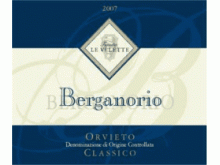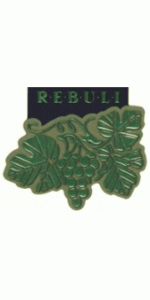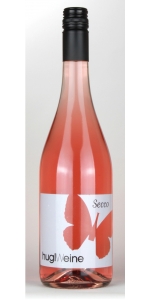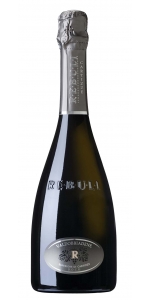Velette Orvieto Secco 2011
| Country: | Italy |
| Region: | Umbria |
| Winery: | Tenuta Le Velette |
| Grape Type: | Trebbiano |
| Vintage: | 2011 |
| Bottle Size: | 750 ml |
All older vintage wines have been purchased from a single collectors cellar. Pictures can be requested before shipment.
All older vintage wines have been purchased from a single collectors cellar. Pictures can be requested before shipment.
Rebuli Prosecco is a noble wine with a bright straw color, made from a selection of Prosecco grapes, which highlights the flavors and perfumes of the area. It is ideal for important occasions and as an aperitif. It is also excellent with risotto and noble meat.
"Pretty silvery straw color. Orange, juicy lemon, peach aromas with a crisp, lightly effervescent, fruity-yet-dry medium body and a long, tangy mineral, starfruit and spice accented finish. Exceptional flavorful, balanced and stylish. A perfect aperitif."
World Wine Championship Award: GOLD MEDAL
Beverage Testing Institute - May 9th 2011 - 91 points (Exceptional)
"Toasty, which makes this a little more champagnelike and perhaps more familiar to consumers. Nice balance; quite refreshing."
- Washington Post (Dec 08) - VERY GOOD
"This wine is so much fun that it seems vaguely illegal. Lightly floral in aroma, it shows fresh but restrained fruit flavors. The effervescence is abundant but soft, yet the wine remains structural and refreshing thanks to crisp acidity. Clearly the top pop for parties." - Washington Post (2006)
"Very pale straw. Very fine mousse. Nice elegant bead. Aromas of fresh bread dough, pear, touch of marzipan. Light attack. Semi-dry. Licorice note on palate. Soft, light. Simple, light pear flavors."
- International Wine Review (Dec 08)
This large Spumante estate with just over 100 acres of vines produces high-quality Prosecco. The non-vintage Rebuli Prosecco di Valdobbiadene Extra Dry is light-bodied and flowery with plenty of white peach, orange and pineapple notes in its exotic aromatics and flavors. It is off-dry, but most consumers would consider it to be a dry sparkling wine. Drink it over the next 12-18 months.-Robert Parker 90 Points
Cortenova Prosecco Spumante NV is 100 percent Prosecco
This Prosecco comes from the highly esteemed area of Valdobbiadene. There are two recognized quality zones for Prosecco, Conegliano and Valdobbiadene. Of the two, Valdobbiaden has always been recognized a having the superior quality due to its naturally higher acidity and its more northern location.
The vineyards lie at 350 meters above sea level. The vines are an average of 25 years old.
The grapes are soft pressed and the free run juice is placed in stainless steel. There is a brief maceration period of 4 hours. Specially selected yeast are added and fermentation is controlled at 20° C. There is no malolactic fermentation and the wine is transferred to autoclaves and a second fermentation is induced following the Charmat tradition. When the desired atmospheric pressure is reached (usually 1 month) the wine is bottled.
Light straw colored with greenish reflections. The perlage is fine and continuous. Fragrant bouquet full of flowers and almonds. In the palate it is fresh and clean with a soft body and a pleasing sparkle. The fruit is subtle and reminiscent of apples and pears with a hint of almond in the background. The finish is inviting.
Can be drunk by itself as an aperitif or with seafood and fish, pastas with cream sauces, chicken and fresh cheeses.
Review:
"Pale straw color. Bright, attractive aromas and flavors of roasted lemons and kiwis, green nectarine, nougat, and grass with a soft, vibrant, spritzy, dry-yet-fruity medium body and a tingling, complex, medium-length spiced clementine and delicate herbal honey finish with silky, crunchy, fruit tannins and no oak. A delicious, nicely layered Prosecco with an elegant style." - Beverage Testing Institute (November 23rd 2015), 91 pts, Best Buy
SALE!
Hugl Zweigelt Secco Rose is made from 100% Zweigelt
Despite its relative youth, Zweigelt is actually an Austrian classic. This variety was created in 1922, when Dr. Fritz Zweigelt crossed two grapes - St Laurent and Blaufränkisch. Originally, it was intended for the new variety to be called Rotburger, referring to the place where it was born, Klosterneuburg. But this name never took hold, and instead, Zweigelt was named after the man who was the key in its development.
Today, Zweigelt is the most widely planted red variety in Austria, growing in nearly 9% of this country's vineyards. It is a robust grape, highly resistant to dryness, frost and various diseases.
Lively, fruity bouquet of strawberry, cherry and floral aromas. Refreshing and beautifully balanced, this is a great wine to enjoy as an aperitif. This is a Secco for the whole day and the whole night
The wine is made of 100% Zweigelt grapes of 15-35 years old (25 years old in avarage).
The soil is mainly loam and loess.
It is made using the Charmat method and the wine is aged for 3 months on the lees in stainless steel tanks.
The wine is slightly filtered before bottling.
Drink by itself as an aperitif, it is also a great picnic or brunch wine and will be a good pick to celebrate any occasion.
Rebuli Prosecco Cartizze Grand Cru is a noble wine with a clear straw color, it exhibits pleasant and delicate fruity flavors and is a perfect match to desserts.
Review:
Coming from a single Grand Cru vineyard and 100% Glera, the NV Prosecco Cartizze offers a gorgeously pure nose of green apples, leafy herbs, and chalky minerality, and it opens up nicely with time in the glass. Beautiful balanced and medium-bodied, with high yet integrated acidity, it's a serious, balanced, impressive Prosecco that will evolve over the coming decade.
-Jeb Dunnuck 93 Points
Velette Orvieto Secco 2011 is made from 30% Trebbiano, 30% Grechetto, 20% Malvasia, 15% Verdello and 5% Drupeggio.
The result of centuries of devotion, selection and experience, this wine is the taste portrait of this area: cool as the air on the Orvieto rock, soft as the surrounding hills, direct/candid/plain/frank/open and sincere like the local people. The typically straw yellow colour with greenish tints illustrates its youthfulness. Delicate floral flavours with a light acidity to preserve them melt on the palate and then there is a characteristic slightly bitter after-taste. A joyful wine, sociable, rounded in its reliable simplicity, a wine that is always a good accompaniment.
Excellent as a pleasant, light-hearted aperitif, it goes well with vegetable or fish hors d'oeuvres and first courses in general. Recommended temperature: 8 – 10 ° C
A tribute to the three families of workers who were responsible for the farms on this hillside from the early 19th century and who have cultivated the grape varieties of Orvieto D.O.C. for generations.
The Tenuta Le Velette Estate
The hill on which the Le Velette estate is situated, to the east of the rock on which stands Orvieto, has always been a point of great agricultural and strategic interest in the course of its three thousand year history. The position, controlling a good part of the valley of Orvieto, the volcanic terrain exposed to the sun from dawn till dusk, and the special microclimate with significant thermal swings between night and day have always been its good fortune.
The first to see its great wine-growing potential were the Etruscans, the people who had already in the 7th century B.C. imported the vine from the Greeks. They certainly used the hill as a rural settlement for its cultivation and dug grottoes in the tufo rock, (just as we still do today), which offered excellent conditions for wine conservation. During Roman times, the hillside kept its wine-making role but developed significantly also as a strategic check point: right in the middle of the present estate, where Villa Felici stands today, a control tower was built and a resting-place for travellers, which led to significant development in the area.
After a difficult period of barbarian and Longobard invasions, the area regained great importance as papal state land. In this period the Etruscan grottoes were extended and became a safe refuge and place of worship for the first monks who settled there soon after.
With the advent of feudalism, the area passed into the hands of the Negroni counts, feudal lords of a nearby village, preserving its wine-making function for centuries before being given in endowment to a monastic order by a descendent who had become an abbot.
At the unification of Italy everything went to the city of Orvieto, which sold the estate to the Felici family. And so began the first experimentations in the vineyard and the cellar which led in very few years to the production of excellent wines, as is testified by the medals won in that period in Roman oenological competitions. The estate's wine went into commerce in the new-born Italy.
The fundamental step towards modern viticulture and oenology was taken in the 1950s when the brilliant Tuscan agronomist, Marcello Bottai, and his wife Giulia, a descendent of the Felici family, chose to make the estate their home and life project. This was the start of a period of development geared to a proper appreciation of the full potential not only of the firm but also of the whole district. The production of high quality wines was established along with the setting up of systems for the development and protection of Orvieto viticulture. A fundamental move was the foundation with other producers of what would become the present consortium for the safeguard of Orvieto wines. An absolutely innovative vision for the times that the young couple not only had had the wit to conceive but which they also had the courage and determination to bring into existence.
The Tenuta Le Velette Vineyard
They carefully and selectively harvest from their own 90 hectares (222 acres) of vineyards. The excellent exposure provides all day sun and the rich tufaceous soil is of volcanic origin.
- back
Hickinbotham Brooks Road Shiraz is made from 100 percent Shiraz.
After the hand-picked Shiraz clusters were delivered from high country (210-230 meters) by Viticulturer Michael Lane, the winemaker destemmed and sorted the whole berries into open fermenters. The cold soak was four days, the skins plunged three times daily, and the minimum time on skins was eighteen days. The wine was then basket pressed; its free run and pressings kept separate. To minimize filtration at bottling, three rack-and-returns were conducted over fifteen months as the wine seasoned in a mixture of Burgundy-coopered barrels.
This Shiraz shows the characters this vineyard has displayed since the start, but perhaps in a more elegant, harmonious and balanced form. Its consistency is comforting and reassuring, buttressed by blue and black fruit notes throughout. It is readily enjoyable but has all the structure, acid and tannin to offer decades of rewards from cellaring.
Review:
A rich, succulent mix of dark chocolate, spiced plum, wild blackberry and black licorice notes. Showcases both power and elegance, with chai, cigar box, violets and dried sage notes, velvety and generous, on the long, generous finish. Drink now through 2035. 1,900 cases made, 370 cases imported
-Wine Spectator 95 Points
Holocene Aureolin Chardonnay is made from 100 percent Chardonnay.
Native yeast, no SO2 added at crush
Fermentation in stainless and neutral oak, including feuillettes
Elevage – 9 months in 50% new oak
164 cases produced










